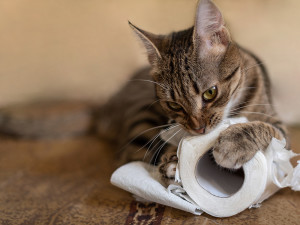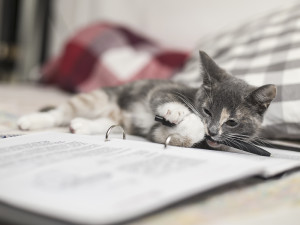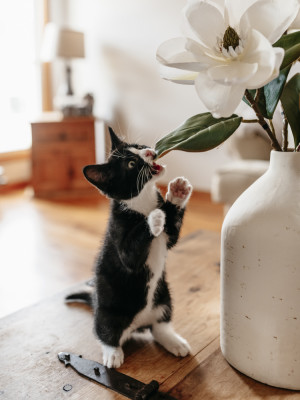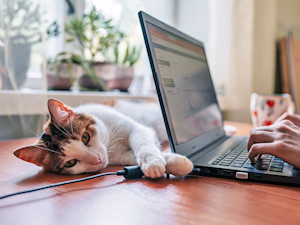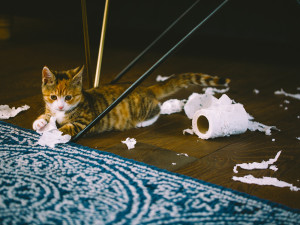Why Does My Cat Eat Legos? How to Prevent Pica in Cats
Those are for building, not eating, bud.

Share Article
In This Article:
Why Does My Cat Eat Legos? What Is Pica in Cats? Could It Be a Medical Problem? When to Consult a Veterinarian How to Prevent Pica in Cats
You leave the room for five minutes. When you return, your cat is crouched over a Lego piece, entirely focused. Before you can stop them, they swipe it up and shove it in their mouth. Panic sets in. You pry their jaw open and remove the tiny plastic cube, wondering for the 10th time why your cat insists on eating things that aren’t food.
As weird as it looks, chewing or eating inedible objects is not uncommon in cats. Many cat parents have stories about their cat swallowing string, chewing on plastic, or sneaking socks. Sometimes, this is just a one-off, but when the behavior becomes frequent, it may be a sign of something called pica. Pica is the tendency to eat non-food items, and in cats, it can be triggered by boredom, stress, medical issues, or learned behavior.
This guide breaks down why your cat might be eating Legos, what cat pica is, how to know if something more serious is going on, and what you can do to stop it before it becomes dangerous.

Why does my cat eat legos?
Cats often chew or eat plastic objects like Legos because of a combination of curiosity, texture appeal, and unmet needs. In some cases, it is a sign of a deeper behavioral pattern or medical condition.
Curiosity and texture fascination
Cats explore the world with their paws and mouths. To a cat, a Lego is an interesting object. It is smooth, rigid, and makes noise when batted around. Kittens, in particular, are prone to mouthing things as a form of play and investigation. Some adult cats retain this behavior and will chew on strange objects simply because they feel satisfying in their mouths.
Boredom or lack of stimulation
If your cat is alone for most of the day or has limited access to toys and engagement, chewing becomes a form of self-entertainment. Legos are often left on the floor and can easily catch a cat's attention. Bored cats will invent their own games, and those games are not always safe.
Seeking owner attention
Some cats figure out that chewing or playing with forbidden objects results in instant attention. If your cat learns that picking up a Lego makes you rush over, they may repeat the behavior just to get a reaction. Negative attention can be just as rewarding as positive interaction when a cat is feeling ignored.
Teething
For kittens, chewing is often related to teething discomfort. During the teething phase, they will chew on anything that offers relief. This includes shoelaces, wires, corners of furniture, and yes, even Lego bricks. Providing appropriate chew toys during this stage is essential.
Texture or taste
Some cats are oddly attracted to plastic or rubber textures, especially those who have absorbed human scent or food residue. Legos that have been handled frequently might smell interesting or carry subtle residue from food-covered fingers. This is not a healthy source of satisfaction, but it helps explain the behavior.
What is pica in cats?
Pica is a condition where cats eat non-food items consistently and compulsively. While occasional chewing may not be a big deal, repeated ingestion of dangerous objects can lead to intestinal blockages, dental injury, and long-term health risks. Pica is not a standalone diagnosis but rather a symptom of a larger problem.
Cats with pica may chew or swallow fabric, plastic, paper, string, rubber bands, or plant material. Some cats target one specific object while others chew on anything available. This behavior is more than just annoying or destructive. It can be life-threatening if not addressed.
Could it be a medical problem?
Yes, some cases of pica are linked to underlying health problems. If your cat’s behavior is persistent or has developed suddenly, a veterinary visit is necessary.
Nutritional deficiencies
Cats who are not getting the right balance of nutrients may start eating non-food items to compensate. This is most commonly seen in diets lacking in fiber, vitamins, or essential minerals. Feeding a well-balanced, high-quality cat food can help reduce the urge to chew or ingest inappropriate items.
Gastrointestinal issues
Digestive discomfort can sometimes drive cats to eat unusual things. If your cat is dealing with nausea, parasites, or chronic GI issues, they may begin chewing or swallowing objects in an effort to soothe their discomfort. This behavior can further complicate their condition and lead to more serious problems.
Thyroid problems
Hyperthyroidism is a common condition in older cats and can cause sudden changes in appetite and behavior. Cats with thyroid disease may become hyperactive, anxious, and obsessed with eating. If your cat is eating more in general and showing signs of strange cravings, bloodwork can help rule out thyroid issues.
Dental pain or oral discomfort
Pain in the mouth, gums, or teeth may lead a cat to chew on hard objects. While this sounds counterintuitive, the pressure may provide some temporary relief. A veterinary dental exam can identify gum disease, broken teeth, or abscesses that may be contributing to the behavior.
When to consult a veterinarian
You should consult a veterinarian if your cat’s pica behavior is frequent, escalating, or paired with signs of illness.
“If the cat ingests non-edible items, they can become lodged in the cat’s intestines, requiring expensive surgery and risking fatality,” says Dr. Nicholas Dodman, a veterinary behaviorist and professor of animal behavior at Tufts University in Massachusetts.
Persistent or severe behavior
If your cat chews or eats non-food items every day or cannot be redirected, the behavior has gone beyond curiosity. Intervention is necessary before your cat swallows something that causes a blockage or requires surgery.
Signs of illness
Weight loss, vomiting, diarrhea, increased thirst, changes in appetite, or lethargy may signal a medical problem behind the chewing. If these symptoms appear alongside pica behavior, your vet can perform a full diagnostic workup.
Behavioral changes
If your cat suddenly becomes destructive, overly focused on chewing, or anxious in general, behavioral stress may be the root cause. Cats are sensitive to changes in environment and routine. Even subtle shifts can trigger compulsive behaviors like pica.
Proper diagnosis
Your vet may run blood tests, check thyroid levels, perform X-rays, or do a dental exam. The goal is to rule out any physical cause first before assuming the behavior is purely psychological.
How to prevent pica in cats
Preventing pica takes a combination of environmental management, behavioral training, and medical care. Start with these key strategies.
Increase mental and physical stimulation.
Cats need stimulation, just like dogs. Rotate toys regularly, offer puzzle feeders, add vertical climbing spaces, or try window perches. A bored cat is far more likely to invent dangerous behaviors.
Create a safe play environment.
Keep Legos, rubber bands, string, plastic bags, and small objects out of reach. Childproofing is just as important for cats as it is for toddlers. Store dangerous objects in closed drawers or bins and supervise playtime when necessary.
Provide appropriate chew toys.
Offer safe alternatives that satisfy your cat’s urge to chew. Silicone cat chews, rubber toys, and treats designed for dental health can redirect their energy. For kittens, teething toys chilled in the fridge may provide comfort.
Make nutritional improvements.
Review your cat’s diet with your veterinarian. Make sure they are eating a food that meets Association of American Feed Control Officials (AAFCO) nutritional standards for their life stage. If needed, supplements or prescription food may help balance their system.
Reduce stress and anxiety
Stress is a major contributor to pica. Try calming pheromone sprays, establish consistent routines, and provide hiding spots or cozy beds where your cat can retreat. If your cat is highly anxious, your vet may recommend behavioral therapy or anti-anxiety medication.
Engage in regular play.
Daily play sessions help burn off energy and lower stress. Use feather wands, laser pointers, or toys that mimic prey. Playing with your cat not only strengthens your bond but also makes them less likely to chew on things out of frustration or boredom.
Bottom line
Cats who chew or eat Legos are not being difficult or rebellious. They are communicating that something in their environment, routine, or health is out of balance. Whether it is curiosity, hunger, discomfort, or stress, chewing and eating non-food items is a sign that your cat needs support.
By identifying the root cause and making a few changes to your cat’s environment and care routine, you can keep them safe and satisfied. If the behavior continues or becomes more intense, a trip to the vet can uncover underlying health issues that may not be obvious on the surface. Catching and addressing pica early can prevent serious harm and help your cat feel more comfortable, both physically and emotionally.
References
Bradshaw, John W.S., et al. “Factors Affecting Pica in the Domestic Cat.” Applied Animal Behaviour Science, 1997, https://www.sciencedirect.com/science/article/abs/pii/B9780323998680000273opens in new tab.
Bright, Anna, et al. “Successful Treatment of Abnormal Feeding Behavior in a Cat.” Journal of the American Veterinary Medical Association, 2012, https://www.sciencedirect.com/science/article/abs/pii/S1558787812000378opens in new tab.
Dodman, Nicholas. Quoted in “Why Do Cats Lick Plastic Bags?” Live Science, https://www.livescience.com/animals/domestic-cats/why-do-cats-lick-plastic-bagsopens in new tab.
Magle, Seth B., et al. “Factors Influencing Body Condition in Stray Cats.” Journal of Urban Ecology, vol. 6, no. 1, 2020, https://doi.org/10.1093/jue/juaa004opens in new tab.

Valerie Mellema
Valerie Mellema has a Bachelor of Science in Agribusiness and Equine Industry from West Texas A&M University. She has been a professional writer for the past 20 years, covering a wide variety of pet health and care topics before founding a nonprofit focused on mental health in children and thoroughbred aftercare. She has four Border Collies and eight retired racehorses.
Related articles
How to Stop Your Cat From Munching On All of Your Precious Plants
Tips to get your cat to quit eating your greens.
![Cat laying on a laptop cord on the desk at home.]()
Is Your Cat Chewing Cords? Here’s What to Do About It
They love to push boundaries, but let’s nip this one in the bud.
![A calico tabby kitten chewing and tearing a roll of toilet tissue.]()
Why Does My Cat Chew On Everything?
How to decode your cat’s chewing habits when they’re nibbling on all the things.
Why Does My Cat Eat Grass?
And should they?
Why Does Your Cat Want You to Watch Them Eat
Do they really need an audience?
Why Does Your Cat Lick Plastic?
That’s an interesting choice for a snack...
